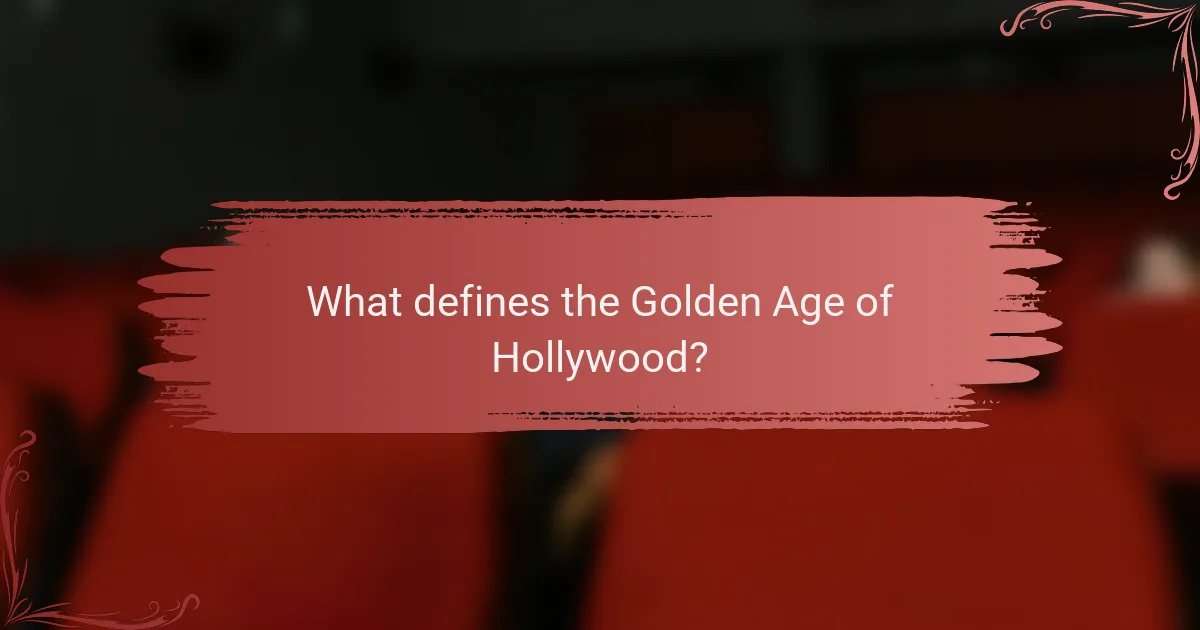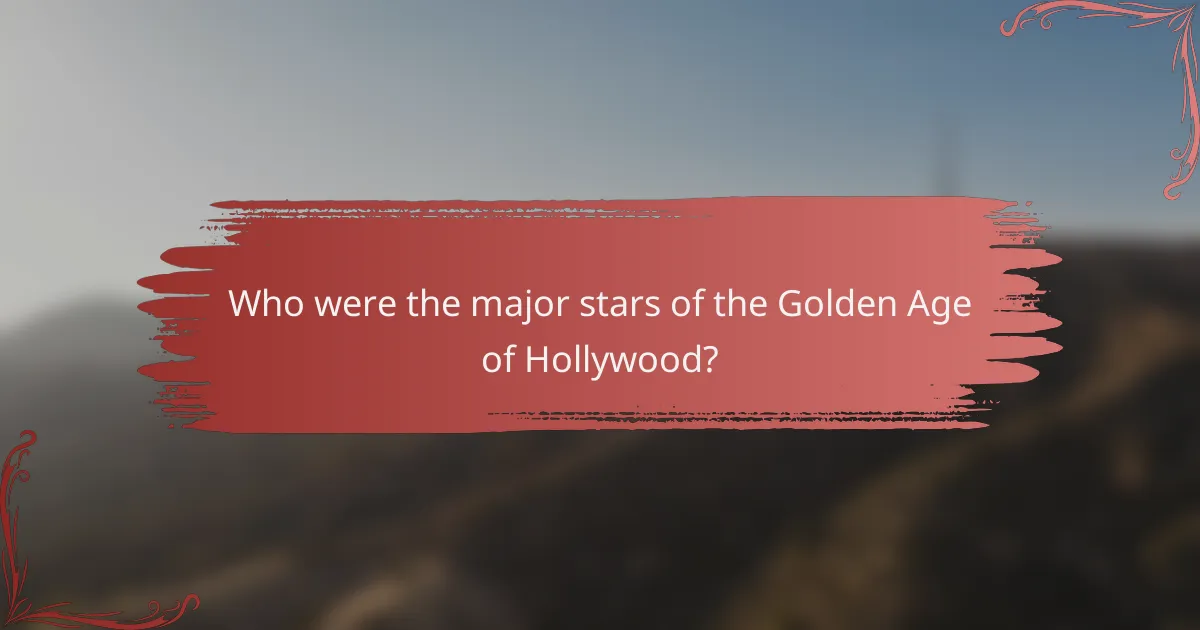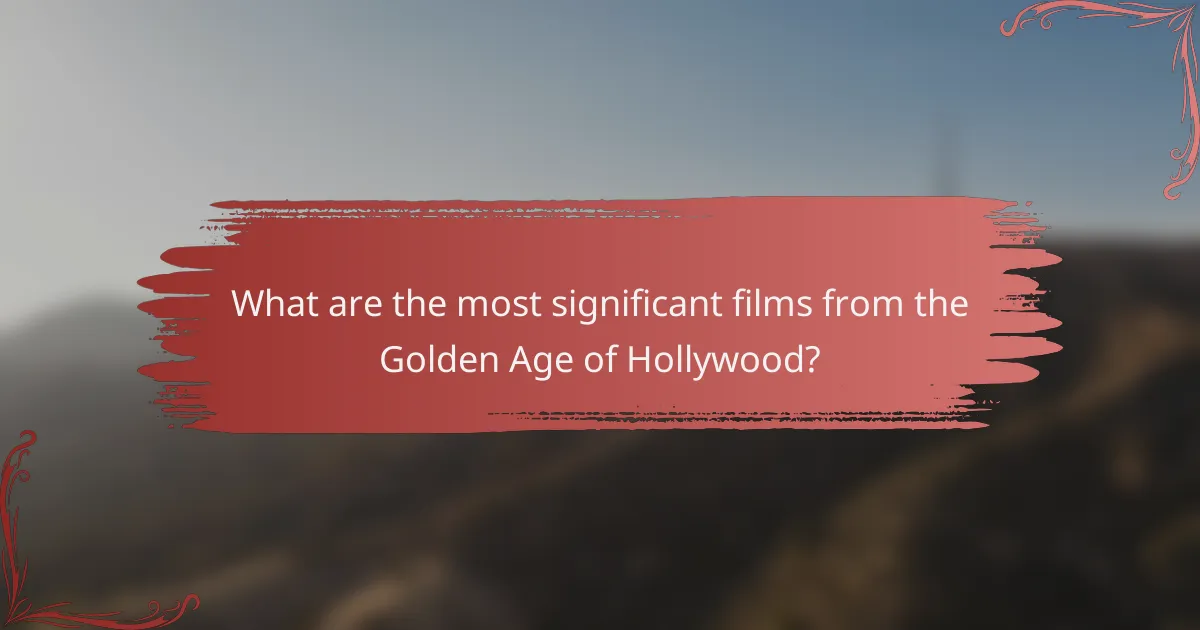The Golden Age of Hollywood refers to a transformative period in the film industry from the late 1920s to the early 1960s, marked by the dominance of major studios such as MGM, Warner Bros., and Paramount. This era produced iconic films like “Gone with the Wind,” “Casablanca,” and “The Wizard of Oz,” while also showcasing legendary stars including Humphrey Bogart, Audrey Hepburn, and Marilyn Monroe. The introduction of sound in films revolutionized cinema, leading to the establishment of the Hollywood studio system that controlled film production, distribution, and exhibition. Additionally, films from this period often reflected contemporary societal themes such as war, romance, and the American Dream, leaving a profound legacy on both cinema and popular culture.

What defines the Golden Age of Hollywood?
The Golden Age of Hollywood is defined by a period of significant growth in the film industry from the late 1920s to the early 1960s. This era is characterized by the dominance of major studios like MGM, Warner Bros., and Paramount. Iconic films produced during this time include classics such as “Gone with the Wind” and “Casablanca.” The era also saw the rise of legendary stars like Humphrey Bogart, Audrey Hepburn, and Marilyn Monroe. The introduction of sound in films, known as “talkies,” revolutionized the industry in the late 1920s. This period is marked by the establishment of the Hollywood studio system, which controlled the production, distribution, and exhibition of films. Social themes reflected in films often mirrored contemporary societal issues, including war, romance, and the American Dream. The Golden Age of Hollywood left a lasting legacy on cinema and popular culture.
How did the Golden Age of Hollywood impact the film industry?
The Golden Age of Hollywood significantly transformed the film industry. It established the studio system, where major studios controlled production, distribution, and exhibition. This era introduced iconic film genres, such as musicals and film noir. The star system emerged, creating a focus on celebrity culture. Films became a primary form of entertainment for the masses. The introduction of sound in films revolutionized storytelling techniques. The Golden Age also influenced global cinema, inspiring filmmakers worldwide. This period lasted from the late 1920s to the early 1960s, marking a pivotal time in film history.
What are the key characteristics of films from this era?
Films from the Golden Age of Hollywood are characterized by their elaborate production values and star power. They often featured grand narratives that appealed to a wide audience. The use of Technicolor became prominent, enhancing visual storytelling. These films typically included strong moral themes and clear resolutions. They also showcased iconic stars, such as Humphrey Bogart and Audrey Hepburn, who became cultural symbols. The era was marked by the studio system, where major studios controlled production and distribution. Additionally, musicals and romantic comedies flourished during this time, reflecting societal values and escapism. The introduction of sound in film also transformed storytelling techniques significantly.
How did technological advancements shape filmmaking during this period?
Technological advancements significantly shaped filmmaking during the Golden Age of Hollywood. Innovations such as sound synchronization transformed silent films into “talkies,” enhancing storytelling. The introduction of color film, notably with “The Wizard of Oz” in 1939, captivated audiences visually. Cinematic techniques like deep focus and montage editing improved narrative depth and viewer engagement. The use of special effects, exemplified by films like “King Kong” (1933), expanded creative possibilities. Additionally, advancements in camera technology allowed for more dynamic shots and movements. These changes collectively elevated the artistry and commercial viability of films during this era.
Why is the Golden Age of Hollywood considered iconic?
The Golden Age of Hollywood is considered iconic due to its significant cultural impact and groundbreaking films. This era, spanning from the late 1920s to the early 1960s, produced timeless classics that shaped the film industry. Iconic films like “Gone with the Wind” and “Casablanca” set new standards for storytelling and production quality. Major stars such as Humphrey Bogart, Audrey Hepburn, and Marilyn Monroe became cultural symbols and influenced fashion and behavior. The era also introduced innovative filmmaking techniques, including Technicolor and sound, enhancing the cinematic experience. Additionally, the Golden Age reflected societal values and issues, addressing topics such as war, romance, and social change. Its legacy continues to influence contemporary cinema, making it a pivotal period in film history.
What cultural influences are reflected in the films of this era?
The films of the Golden Age of Hollywood reflect various cultural influences, including societal values, historical events, and technological advancements. These films often depicted the American Dream, showcasing themes of success and individualism. They also mirrored the societal norms of the time, including gender roles and racial dynamics. Historical events, such as World War II, influenced film narratives, often emphasizing patriotism and resilience. The rise of consumerism in post-war America was reflected in the glamorous lifestyles portrayed on screen. Additionally, advancements in film technology allowed for more elaborate storytelling and visual effects, impacting audience engagement. Films from this era often served as escapism during difficult times, resonating with the public’s desire for hope and entertainment.
How did societal changes during this time affect film narratives?
Societal changes during the Golden Age of Hollywood significantly influenced film narratives. The rise of the Great Depression led to themes of struggle and resilience in films. Audiences sought escapism, prompting filmmakers to create light-hearted comedies and musicals. World War II shifted narratives towards patriotism and heroism, reflecting societal values. The civil rights movement began to emerge, leading to more diverse characters and stories. Films started to address social issues like poverty and inequality. Changes in gender roles were also evident, with stronger female characters appearing on screen. The introduction of new technologies influenced storytelling techniques and visual styles. Overall, film narratives evolved to mirror the complexities of contemporary society.

Who were the major stars of the Golden Age of Hollywood?
The major stars of the Golden Age of Hollywood included Humphrey Bogart, Katharine Hepburn, and Clark Gable. Humphrey Bogart was known for his roles in classic films like “Casablanca.” Katharine Hepburn was celebrated for her strong performances in movies such as “Guess Who’s Coming to Dinner.” Clark Gable gained fame for his iconic role in “Gone with the Wind.” Other notable stars included Marilyn Monroe, who became a symbol of the era, and James Stewart, recognized for his versatility. These actors defined the cinematic landscape from the 1920s to the 1960s. Their performances and personas left a lasting impact on American culture and film history.
What contributions did iconic actors and actresses make?
Iconic actors and actresses made significant contributions to the film industry during the Golden Age of Hollywood. They shaped cinematic storytelling through memorable performances. Stars like Humphrey Bogart and Katharine Hepburn became symbols of their era. Their unique acting styles influenced generations of performers. They also played pivotal roles in popularizing genres such as film noir and romantic comedy. Furthermore, their off-screen personas often mirrored societal values and issues. For instance, many advocated for civil rights and social change. Their legacy continues to inspire contemporary cinema and culture.
How did their performances shape the perception of film as an art form?
Their performances elevated film to the status of a legitimate art form. Actors like Humphrey Bogart and Katharine Hepburn brought depth and complexity to their roles. This authenticity resonated with audiences and critics alike. Their ability to convey genuine emotion challenged previous perceptions of film as mere entertainment. The storytelling in films became more sophisticated due to their contributions. Iconic performances in films like “Casablanca” and “The Philadelphia Story” showcased the potential of cinematic narratives. These films highlighted the power of visual storytelling and character development. As a result, film began to be recognized alongside theater and literature as a significant artistic medium.
What personal stories of these stars contributed to their legendary status?
The personal stories of stars from the Golden Age of Hollywood significantly contributed to their legendary status. Many faced adversity in their early lives. For instance, Judy Garland struggled with mental health issues and a tumultuous childhood. Her resilience and talent made her an enduring icon. Similarly, Humphrey Bogart overcame a troubled upbringing and personal setbacks. His gritty persona resonated with audiences, solidifying his legendary status. Additionally, Marilyn Monroe’s rise from poverty to fame highlighted her tenacity. Her story of overcoming personal struggles captivated the public. These narratives of perseverance and triumph added depth to their on-screen personas. They became symbols of hope and aspiration for many.
How did the studio system influence the careers of these stars?
The studio system significantly influenced the careers of stars by controlling their contracts and film appearances. Major studios, like MGM and Warner Bros, signed actors to exclusive contracts. This limited their opportunities outside the studio but ensured steady work. Stars became brand names, with studios heavily marketing their images. The system also dictated the types of roles actors played, often typecasting them. This shaped public perception and career trajectories. For example, stars like Judy Garland were molded into specific personas. Ultimately, the studio system created both opportunities and constraints for Hollywood’s leading figures.
What role did contracts and publicity play in their success?
Contracts and publicity were crucial for the success of stars during the Golden Age of Hollywood. Contracts ensured that actors had stable employment and defined their roles in films. They often included clauses that protected the studios’ investments. Publicity generated buzz and excitement around films and actors. It created a larger-than-life image, drawing audiences to theaters. Stars were often marketed through magazine covers and interviews. This heightened visibility contributed to their popularity and box office success. The synergy between contracts and publicity established a strong brand for both films and actors.
How did the star system affect audience engagement with films?
The star system significantly enhanced audience engagement with films. It created a strong connection between actors and viewers. Stars became recognizable figures, drawing audiences to theaters. Their popularity often determined a film’s box office success. For example, films featuring major stars like Clark Gable and Bette Davis attracted larger audiences. The star system also influenced marketing strategies. Studios promoted films based on the star power of the cast. This led to increased anticipation and excitement among fans. Ultimately, the star system shaped audience preferences and viewing habits.

What are the most significant films from the Golden Age of Hollywood?
The most significant films from the Golden Age of Hollywood include “Gone with the Wind,” “Casablanca,” and “The Wizard of Oz.” “Gone with the Wind,” released in 1939, is renowned for its epic storytelling and production scale. It won eight Academy Awards, including Best Picture. “Casablanca,” released in 1942, is celebrated for its memorable dialogue and complex characters. It won three Academy Awards, including Best Picture. “The Wizard of Oz,” also released in 1939, is famous for its innovative use of Technicolor and enduring music. It has become a cultural touchstone in American cinema. Other notable films include “Citizen Kane,” “Singin’ in the Rain,” and “It’s a Wonderful Life.” These films exemplify the artistic and technical achievements of the era.
Which films are considered masterpieces and why?
Films considered masterpieces include “Citizen Kane,” “Casablanca,” and “The Godfather.” “Citizen Kane” is renowned for its innovative narrative structure and cinematography. It explores themes of ambition and loss, making it a profound commentary on American society. “Casablanca” is celebrated for its iconic dialogue and unforgettable performances. It reflects wartime romance and sacrifice, resonating deeply with audiences. “The Godfather” is acclaimed for its complex characters and storytelling. It delves into the intricacies of family and power, leaving a lasting impact on cinema. Each of these films has received critical acclaim and is frequently referenced in discussions of cinematic excellence.
How did these films address contemporary social issues?
These films addressed contemporary social issues by reflecting societal norms and challenges of their time. They tackled themes such as war, poverty, and civil rights. Films like “Gone with the Wind” depicted the complexities of race and class. “The Grapes of Wrath” highlighted the struggles of the Great Depression. “To Kill a Mockingbird” confronted racial injustice and moral growth. These narratives resonated with audiences, prompting discussions on social change. The portrayal of these issues often influenced public perception and policy. Their impact continues to be analyzed in film studies and cultural critiques.
What innovative techniques were used in these films?
Innovative techniques used in films during the Golden Age of Hollywood included the introduction of Technicolor, deep focus cinematography, and montage editing. Technicolor allowed filmmakers to create vibrant and realistic color palettes, enhancing visual storytelling. Deep focus cinematography enabled multiple planes of action to be in sharp focus simultaneously, enriching the narrative depth. Montage editing, popularized by directors like Sergei Eisenstein, facilitated the juxtaposition of images to convey complex ideas and emotions. These techniques collectively transformed cinematic language, leading to a more immersive viewer experience.
How did genre evolution occur during the Golden Age?
Genre evolution during the Golden Age occurred through the blending of styles and the emergence of new themes. The period saw the rise of iconic genres like film noir, musicals, and westerns. Filmmakers experimented with narrative structures and visual techniques. This experimentation led to a diversification of storytelling methods. The influence of societal changes also shaped genre development. For example, post-war disillusionment fueled the rise of darker narratives in film noir. The popularity of musicals reflected a desire for escapism during tough economic times. Box office successes influenced studios to invest in genre-specific films. The Golden Age thus marked a significant transformation in cinematic genres.
What are the main genres that emerged or transformed during this period?
The main genres that emerged or transformed during the Golden Age of Hollywood include film noir, musicals, and westerns. Film noir became prominent in the 1940s, characterized by its dark themes and moral ambiguity. Classic examples include “Double Indemnity” and “The Maltese Falcon.” Musicals flourished in this era, showcasing elaborate song and dance numbers. Iconic films like “Singin’ in the Rain” exemplify this genre’s appeal. Westerns also saw significant transformation, emphasizing the rugged individualism of characters. Films such as “Stagecoach” redefined the genre’s narrative and visual style. These genres reflected societal changes and the evolving tastes of audiences during this pivotal period in cinema history.
How did audience preferences shape genre development?
Audience preferences significantly influenced genre development during the Golden Age of Hollywood. As audiences showed a preference for certain themes, studios adapted their productions accordingly. The rise of musicals in the 1930s reflected a desire for escapism during the Great Depression. Similarly, film noir emerged in response to post-war disillusionment, showcasing darker narratives that resonated with viewers.
The popularity of romantic comedies highlighted the audience’s longing for lighthearted entertainment. Box office successes guided studios in making more films within favored genres. Historical data indicates that genres like westerns and horror evolved based on audience demand and cultural trends. Consequently, audience preferences directly shaped the trajectory of genre evolution, leading to the creation of iconic films that defined the era.
What lessons can be learned from the Golden Age of Hollywood?
The Golden Age of Hollywood teaches the importance of storytelling and character development. Films from this era emphasized strong narratives that resonated with audiences. Iconic movies like “Casablanca” and “Gone with the Wind” showcased complex characters and emotional depth. These films often reflected societal issues, providing commentary on contemporary life. The era also highlighted the significance of star power in attracting audiences. Major stars like Humphrey Bogart and Audrey Hepburn became cultural icons, influencing fashion and social trends. Additionally, the Golden Age demonstrated the value of collaboration in filmmaking. Directors, writers, and actors worked closely to create memorable cinema. This collaborative spirit contributed to the lasting impact of the films produced during this time.
How can modern filmmakers apply these insights to today’s cinema?
Modern filmmakers can apply insights from the Golden Age of Hollywood by focusing on strong storytelling and character development. This era emphasized narrative depth, which resonates with contemporary audiences. Filmmakers should also consider the cultural reflections present in classic films. These films often addressed societal issues relevant to their time. By incorporating similar themes, filmmakers can create impactful cinema today. Additionally, the use of innovative cinematography and production techniques from that period can enhance visual storytelling. Historical context, such as the influence of major stars, can guide casting decisions. Understanding audience expectations from the Golden Age can inform marketing strategies. Overall, these insights can help create films that are both entertaining and meaningful.
What best practices can be derived from the successes and failures of this era?
Best practices from the Golden Age of Hollywood include focusing on storytelling, star power, and audience engagement. Successful films prioritized strong narratives that resonated with viewers. Iconic stars became central to marketing strategies, drawing audiences to theaters. Engaging with societal issues enhanced the relevance of films, creating deeper connections with audiences. Learning from failures, studios recognized the importance of diversity and representation. They understood that neglecting these aspects could lead to public backlash. Adapting to changing audience preferences proved essential for sustained success. These practices shaped the film industry and continue to influence modern filmmaking.
The Golden Age of Hollywood refers to a transformative period in the film industry from the late 1920s to the early 1960s, marked by the dominance of major studios and the emergence of iconic films and stars. This era introduced significant technological advancements, such as sound synchronization and Technicolor, which revolutionized storytelling and visual aesthetics. Key films like “Gone with the Wind,” “Casablanca,” and “The Wizard of Oz” reflect contemporary societal issues and shaped cinematic narratives. Major stars, including Humphrey Bogart and Audrey Hepburn, became cultural icons, influencing public perception and the star system’s evolution. This article explores the characteristics, impact, and legacy of the Golden Age, providing insights into its significance in film history.